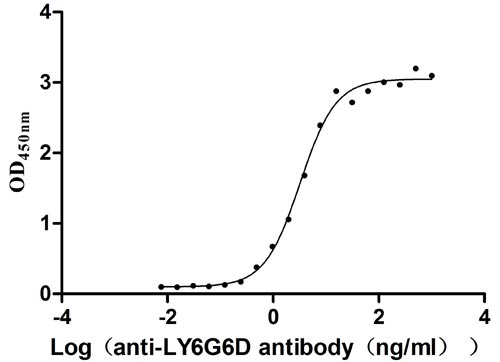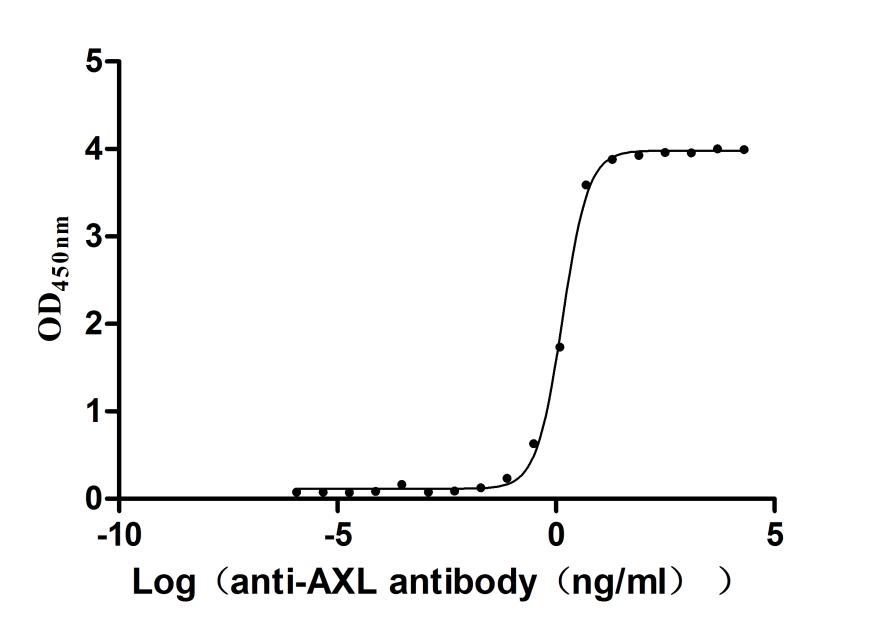Recombinant Human C-X-C motif chemokine 11 (CXCL11)
-
货号:CSB-YP006241HU
-
规格:
-
来源:Yeast
-
其他:
-
货号:CSB-EP006241HU
-
规格:
-
来源:E.coli
-
其他:
-
货号:CSB-EP006241HU-B
-
规格:
-
来源:E.coli
-
共轭:Avi-tag Biotinylated
E. coli biotin ligase (BirA) is highly specific in covalently attaching biotin to the 15 amino acid AviTag peptide. This recombinant protein was biotinylated in vivo by AviTag-BirA technology, which method is BriA catalyzes amide linkage between the biotin and the specific lysine of the AviTag.
-
其他:
-
货号:CSB-BP006241HU
-
规格:
-
来源:Baculovirus
-
其他:
-
货号:CSB-MP006241HU
-
规格:
-
来源:Mammalian cell
-
其他:
产品详情
-
纯度:>85% (SDS-PAGE)
-
基因名:
-
Uniprot No.:
-
别名:b R1; b-R1; Beta-R1; betaR1; C-X-C motif chemokine 11; Chemokine (C-X-C motif) ligand 11; Chemokine C-X-C motif ligand 11; CXC11; CXCL11; CXL11_HUMAN; H174; I TAC; I-TAC; Interferon gamma inducible protein 9; Interferon gamma-inducible protein 9; Interferon inducible T cell alpha chemoattractant; Interferon-inducible T-cell a chemoattractant I-TAC; Interferon-inducible T-cell alpha chemoattractant; IP 9; IP-9; IP9; ITAC; MGC102770; SCYB11; SCYB9B; Small inducible cytokine B11; Small inducible cytokine subfamily B (Cys-X-Cys) member 11; Small inducible cytokine subfamily B (Cys-X-Cys) member 9B; Small inducible cytokine subfamily B; member 11; Small inducible cytokine subfamily B; member 9B; Small-inducible cytokine B11
-
种属:Homo sapiens (Human)
-
蛋白长度:Full Length of Mature Protein
-
表达区域:22-94
-
氨基酸序列FPMFKRGRC LCIGPGVKAV KVADIEKASI MYPSNNCDKI EVIITLKENK GQRCLNPKSK QARLIIKKVE RKNF
-
蛋白标签:Tag type will be determined during the manufacturing process.
The tag type will be determined during production process. If you have specified tag type, please tell us and we will develop the specified tag preferentially. -
产品提供形式:Lyophilized powder
Note: We will preferentially ship the format that we have in stock, however, if you have any special requirement for the format, please remark your requirement when placing the order, we will prepare according to your demand. -
复溶:We recommend that this vial be briefly centrifuged prior to opening to bring the contents to the bottom. Please reconstitute protein in deionized sterile water to a concentration of 0.1-1.0 mg/mL.We recommend to add 5-50% of glycerol (final concentration) and aliquot for long-term storage at -20℃/-80℃. Our default final concentration of glycerol is 50%. Customers could use it as reference.
-
储存条件:Store at -20°C/-80°C upon receipt, aliquoting is necessary for mutiple use. Avoid repeated freeze-thaw cycles.
-
保质期:The shelf life is related to many factors, storage state, buffer ingredients, storage temperature and the stability of the protein itself.
Generally, the shelf life of liquid form is 6 months at -20°C/-80°C. The shelf life of lyophilized form is 12 months at -20°C/-80°C. -
货期:Delivery time may differ from different purchasing way or location, please kindly consult your local distributors for specific delivery time.Note: All of our proteins are default shipped with normal blue ice packs, if you request to ship with dry ice, please communicate with us in advance and extra fees will be charged.
-
注意事项:Repeated freezing and thawing is not recommended. Store working aliquots at 4°C for up to one week.
-
Datasheet :Please contact us to get it.
相关产品
靶点详情
-
功能:Chemotactic for interleukin-activated T-cells but not unstimulated T-cells, neutrophils or monocytes. Induces calcium release in activated T-cells. Binds to CXCR3. May play an important role in CNS diseases which involve T-cell recruitment. May play a role in skin immune responses.
-
基因功能参考文献:
- V2O5 induction of CXCL8 and CXCL11 chemokines may lead to the appearance and perpetuation of an inflammatory reaction into the dermal tissue. Further studies are required to evaluate dermal integrity and manifestations in subjects occupationally exposed, or living in polluted areas. PMID: 29901202
- BK polyomavirus infection can induce CXCL11 gene expression in kidney transplant patients. PMID: 27759557
- CXCL11 production in cerebrospinal fluid was found in herpes simplex meningitis, but not in herpes simplex encephalitis. PMID: 28693588
- Neuroendocrine-like cells promote the chemotaxis activity of tumor-associated macrophages (TAM) via CXCL10 and CXCL11. PMID: 27034164
- High CXCL11 expression is associated with clear-cell renal cell carcinoma. PMID: 26910919
- this study shows that melanoma peptides vaccination and intratumoral administration of IFNgamma increases production of CXCL11 in patient tumors PMID: 27522581
- Downregulation of CXC chemokine ligand 11 can inhibit tumor angiogenesis, suggesting that anti-CXC chemokine ligand 11 therapy may offer an alternative treatment strategy for TWIST1-positive ovarian cancer PMID: 28488542
- CXCL8/11 may promote the disease progression of osteoarthritis (OA), and may also serve as new therapeutic targets for treatment of OA. PMID: 27567247
- this study shows that oxidative signaling inhibits T lymphocyte chemotaxis to the inflammatory chemokine CXCL11 PMID: 28363904
- The homozygous variant CXCL11 AA genotype (rs6817952) is associated with an increased risk of contact allergy. PMID: 27356947
- In contrast to elevated 1st trimester levels of IP-10 previously found in the maternal serum of women who later developed preeclampsia, this study found lower umbilical cord IP-10 and ITAC plasma levels in near-term gestations with established severe preeclampsia. PMID: 25741937
- CXCL11 levels are mainly increased in patients with non-alcoholic cirrhosis and high portal pressure. Moreover, levels of CXCL11 might predict long-time survival of cirrhotic patients undergoing TIPS. PMID: 26212075
- higher concentration is associated with neutrophils accumulation in the alveolar space of Systemic Lupus Erythematosus patients with pulmonary fibrosis PMID: 26275808
- Developmental expression patterns of chemokines CXCL11, CXCL12 and their receptor CXCR7 in testes PMID: 25810367
- congruent with the concept that inflammation plays a key role in the pathogenesis of LV dysfunction, MIG, IP10 and I-TAC add diagnostic accuracy over and beyond NT-pro BNP. PMID: 26506526
- Resveratrol substantially inhibited the proinflammatory cytokines-induced CXCL11 production while partially blocking nuclear factor-kappaB activation. PMID: 25890876
- Common variants of CXCR3 and its ligands CXCL10 and CXCL11 are associated with vascular permeability of dengue infection in peninsular Malaysia. PMID: 25858769
- Cyclic stretch significantly induced ESC secretion of CXCL8 and CXCL1 and neutrophil chemotaxis. Stretch also increased MMP-1, MMP-2, and MMP-3 activity, activin A secretion, and activity in ESC. PMID: 25605062
- High CXCL11 expression is associated with acute cellular rejection. PMID: 25251331
- These findings functionally integrate K17, hnRNP K, and gene expression along with RSK and CXCR3 signaling in a keratinocyte-autonomous axis and provide a potential basis for their implication in tumorigenesis PMID: 25713416
- The homozygosity for the CXCL9 rs10336 (T), CXCL10 rs3921 (G), and CXCL11 rs4619915 (A) alleles is associated with the higher likelihood of significant liver fibrosis in HIV-infected patients coinfected with hepatitis C virus genotype 1. PMID: 25559603
- The chemokine CXCL11 is produced by mesenchymal stem cells and interacts with CXCR3. PMID: 24526602
- CXCL11 displays antimicrobial activity against E. coli and S. aureus. PMID: 12949249
- The expression of MIF mRNA was compared with VEGF mRNA expression and with mRNA expression of other chemokines related to neo-angiogenesis, such as CXCL12, CXCL11, CXCL8 and CXCR4, in human endometrial cancer tissue and normal endometrium. PMID: 23985752
- CXCL11 was mildlylavage fluid during diffuse alveolar damage, but not during acute rejection or lymphocytic bronchiolitis. Elevated CXCL11 was associated with increased risk of chronic allograft dysfunction. PMID: 24063316
- Our study demonstrates in mixed cryoglobulinemia and hepatitis C vs controls: (i)high serum CXCL9 and CXCL11, significantly associated with the presence of active vasculitis; (ii) a strong relationship between circulating CXCL9 and CXCL11 PMID: 23527708
- CXCR3 ligands CXCL10, CXCL9 and CXCL11 were measured in 245 children with opsoclonus-myoclonus syndrome and 81 controls. PMID: 23600831
- There was no difference in expression of I-TAC between immune thrombocytopenic purpura patients and healthy controls. PMID: 23158864
- Expression of CXCL9, -10, and -11 chemokines and their receptor CXCR3 increases in the aqueous humor of patients with herpetic endotheliitis. PMID: 22367045
- This study demonistrated that CXCL11, absent from normal muscle fibers, were induced in DMD myofibers. and up regulattion on blood vessel endothelium of DMD patients. PMID: 23225384
- Our study first demonstrates higher serum levels of CXCL11 chemokine in patients with mixed cryoglobulinemia than in hepatitis C virus-positive patients, and in particular in the presence of autoimmune thyroiditis. PMID: 22160826
- In chronic graft-vs-host disease, increased levels of the Th1-associated chemokines CXCL9, CXCL10, and CXCL11 led to recruitment of CXCR3+ T cells from the peripheral blood into affected tissues. PMID: 23012327
- Elevated BALF concentrations of CXCL11 in systemic sclerosis patients who do not developed lung fibrosis suggest that determination of CXCL11 in BALF could serve as a prognostic factor for pulmonary function decline. PMID: 22691213
- CXCL10, CXCL11, CXCL12 and CXCL13 chemokines are biomarkers in serum and cerebrospinal fluid in patients with tick borne encephalitis PMID: 22008312
- A strong relationship between circulating IFN-gamma and CXCL11 is shown, supporting the role of a T helper (Th)1 cell immune response in the pathogenesis of mixed cryoglobulinemia and hepatitis C. PMID: 21724697
- circulating CXCL11, together with CXCL10, is increased in patients with thyroiditis and hypothyroidism, and is related to CXCL10 levels. PMID: 22168752
- Elevated plasma levels of interferon-gamma and Cys-X-Cys chemokine receptor 3-binding chemokine CXCL11 are present in patients with thoracic aortic aneurysms. PMID: 21962843
- CXCR3 ligands, CXCL9,10,11, are differentially expressed during chronic liver diseases across different disease stages and aetiologies. PMID: 21645215
- We first show that circulating CXCL9 and CXCL11 are increased in patients with thyroiditis and hypothyroidism and are related to each other. PMID: 21470996
- involved in microbial-induced intestinal inflammation and Th17 cell development in ulcerative colitis PMID: 21438871
- A potent dose-dependent inhibition by PPARalpha-agonists was observed on the cytokines-stimulated secretion of CXCL11 in Graves disease and in primary thyrroid culture. PMID: 20810571
- The expression and function of CXCR3 and CXCR7 receptors in cervical carcinoma, rhabdomyosarcoma and glioblastoma cell lines, was evaluated. PMID: 20529825
- Studies indicate that CXCR7 is an interceptor for CXCL12 and CXCL11. PMID: 20036838
- TNFSF14 enhanced IFN-gamma-induced secretion of CXCL10 and CXCL11 from human gingival fibroblasts. PMID: 19939453
- Studies indicate that I-TAC-targeted intervening strategies would have potential application for the alleviation of acute transplant rejection. PMID: 19875106
- I-TAC is a highly potent chemoattractant of normal blood CD4 and CD8 T cell transendothelial migration and a major mediator of blood memory T lymphocyte migration to inflammation. PMID: 12055261
- The IFN-gamma-inducible T cell alpha-chemoattractant was induced in human brain microvascular endothelial cells and astrocytes only after inflammatory stimuli. PMID: 12162873
- These data suggest that IFN-beta acts through PI3K to enhance the transactivation competence of NF-kappa B complexes through phosphorylation of p65 within the TAD of beta-R1. PMID: 12169689
- Levels of ITAC/CXCL11 were found elevated in patients with severe transplantation coronary artery disease (TCAD) compared with long-term survivors of transplantation without TCAD and healthy volunteers who had not undergone transplantation PMID: 12695288
- increased calpain activity in undifferentiated keratinocytes. inhibited calpain activity in fibroblasts. redifferentiated basal keratinocytes limit fibroblast repopulation of dermis of healed wounds while promoting re-epithelialization. PMID: 12787142
显示更多
收起更多
-
亚细胞定位:Secreted.
-
蛋白家族:Intercrine alpha (chemokine CxC) family
-
组织特异性:High levels in peripheral blood leukocytes, pancreas and liver astrocytes. Moderate levels in thymus, spleen and lung. Low levels in placenta, prostate and small intestine. Also found in epidermal basal layer keratinocytes in skin disorders.
-
数据库链接:
HGNC: 10638
OMIM: 604852
KEGG: hsa:6373
STRING: 9606.ENSP00000306884
UniGene: Hs.632592
Most popular with customers
-
Recombinant Human Claudin-4 (CLDN4)-VLPs (Active)
Express system: Mammalian cell
Species: Homo sapiens (Human)
-
Recombinant Human Lymphocyte antigen 6 complex locus protein G6d (LY6G6D) (Active)
Express system: Yeast
Species: Homo sapiens (Human)
-
Recombinant Human Tumor-associated calcium signal transducer 2 (TACSTD2), partial (Active)
Express system: Mammalian cell
Species: Homo sapiens (Human)
-
Recombinant Human Myosin regulatory light polypeptide 9 (MYL9) (Active)
Express system: Yeast
Species: Homo sapiens (Human)
-
Recombinant Human Oncostatin-M (OSM), partial (Active)
Express system: Mammalian cell
Species: Homo sapiens (Human)
-
Recombinant Human Cadherin-6(CDH6),partial (Active)
Express system: Mammalian cell
Species: Homo sapiens (Human)
-
Recombinant Human Tyrosine-protein kinase receptor UFO(AXL),partial (Active)
Express system: Mammalian cell
Species: Homo sapiens (Human)
-
Recombinant Human C-C chemokine receptor type 5 (CCR5)-VLPs (Active)
Express system: Mammalian cell
Species: Homo sapiens (Human)




















